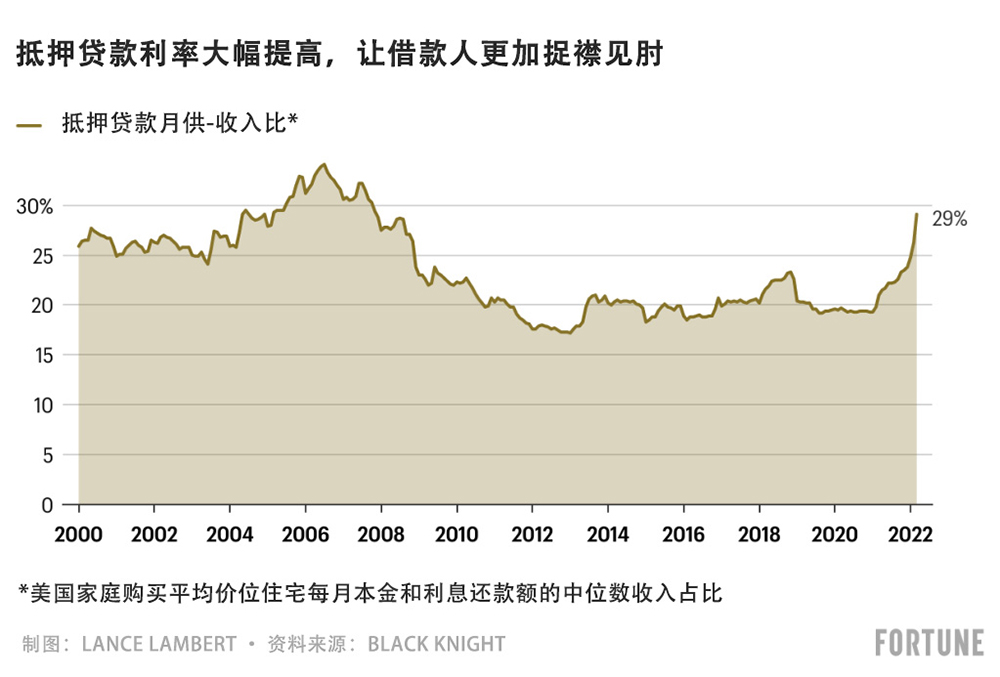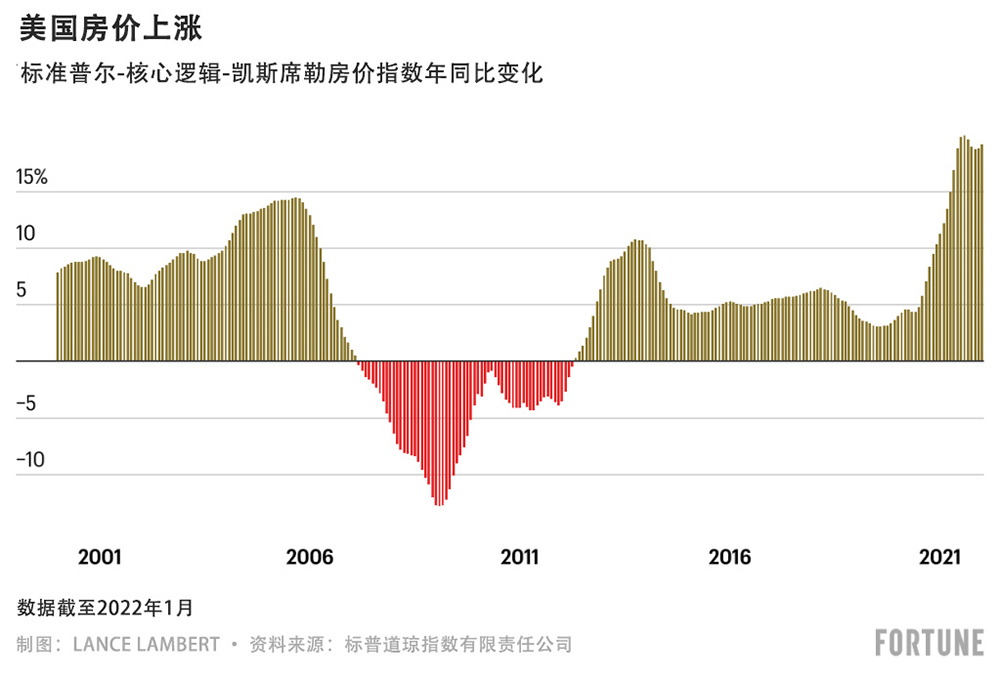過去兩年,,美國房?jī)r(jià)上漲了32.6%,但房?jī)r(jià)飆漲所引發(fā)的財(cái)務(wù)困境,,卻因?yàn)橐咔槠陂g史上最低的抵押貸款利率,,在某種程度上得到了緩解。雖然房?jī)r(jià)暴漲,,許多購房人依舊可以承擔(dān)月供,。但這些好日子已經(jīng)漸行漸遠(yuǎn):隨著抵押貸款利率恢復(fù)到疫情之前的水平,新購房人開始充分感受到高房?jī)r(jià)的影響,。
早在去年12月,,平均30年固定抵押貸款利率為3.11%。借款人以3.11%的利率貸款50萬美元,,月供含本金和利息共計(jì)2,137美元,。目前平均抵押貸款利率為4.72%,同等金額的貸款月供金額為2,599美元,。30年貸款總還款額額外增加了166,106美元,。
抵押貸款利率的快速上漲,導(dǎo)致購房人面臨自2007年以來最糟糕的局面,。至少抵押貸款技術(shù)與數(shù)據(jù)提供商Black Knight的一個(gè)指標(biāo)得出了這樣的結(jié)論,。
Black Knight向《財(cái)富》雜志提供的數(shù)據(jù)顯示,,按當(dāng)前的抵押貸款利率計(jì)算,美國普通家庭抵押貸款購買一套平均價(jià)位的美國住宅,,需要支出29%的月收入,。Black Knight的抵押貸款月供-收入比自2007年以來從未達(dá)到過29%,在自2010年起的十年間平均水平為19.9%,。這與2021年12月相比同樣大幅提高,,當(dāng)時(shí)的月供-收入比為24%。

雖然住房負(fù)擔(dān)能力(或者更準(zhǔn)確地說,,住房負(fù)擔(dān)能力不足)開始表現(xiàn)出與2000年代中期的房地產(chǎn)市場(chǎng)類似的狀況,,但這并不意味著美國會(huì)重現(xiàn)2008年的房地產(chǎn)市場(chǎng)崩潰。
在上次房地產(chǎn)市場(chǎng)繁榮期間,,房屋建筑商以難以持久的方式大量建造房屋,。隨著2006年左右房地產(chǎn)市場(chǎng)的增速開始放緩,很快就出現(xiàn)了供大于求,,導(dǎo)致房?jī)r(jià)進(jìn)一步下跌,。而這一次,房屋建筑商的建造速度甚至沒有跟上需求增長(zhǎng)速度,,也沒有跟上人口結(jié)構(gòu)的變化,。業(yè)內(nèi)人士對(duì)《財(cái)富》雜志表示,如果出現(xiàn)房?jī)r(jià)暴跌,,現(xiàn)有庫存不會(huì)從供應(yīng)嚴(yán)重不足變成與2009年類似的供應(yīng)過剩,。
摩根士丹利(Morgan Stanley)研究人員在上周發(fā)布的一份報(bào)告中寫道:“抵押貸款市場(chǎng)以固定利率為主,因此利率上漲不會(huì)增加現(xiàn)有房主的月供,,但會(huì)對(duì)首次購房人產(chǎn)生嚴(yán)重影響,。穩(wěn)健的抵押貸款承銷會(huì)限制止贖潮,避免強(qiáng)制出售,,從而減少對(duì)房?jī)r(jià)的影響,。”

有越來越多房地產(chǎn)經(jīng)濟(jì)學(xué)家支持通過上調(diào)抵押貸款利率給房地產(chǎn)市場(chǎng)降溫,。他們認(rèn)為,,房?jī)r(jià)上漲速度是不可持續(xù)的,如果房?jī)r(jià)上漲持續(xù)到2022年以后,,可能導(dǎo)致房地產(chǎn)市場(chǎng)過熱,。他們寧愿房地產(chǎn)市場(chǎng)減速,維持可持續(xù)增長(zhǎng),,也不愿意市場(chǎng)面臨泡沫破裂的風(fēng)險(xiǎn),。達(dá)拉斯聯(lián)邦儲(chǔ)蓄銀行(Federal Reserve Bank of Dallas)上個(gè)月發(fā)表了一篇標(biāo)題為《實(shí)時(shí)市場(chǎng)監(jiān)測(cè)發(fā)現(xiàn)美國房地產(chǎn)泡沫正在醞釀的跡象》的論文,顯然引起了經(jīng)濟(jì)學(xué)家們的關(guān)注。
抵押貸款利率上漲能夠給市場(chǎng)降溫,,這種觀點(diǎn)有一定的道理,。畢竟,這將是對(duì)市場(chǎng)需求側(cè)的經(jīng)濟(jì)沖擊:利率上浮不僅會(huì)將部分購房人擠出市場(chǎng),,還意味著部分借款人將失去貸款資格,,因?yàn)榻杩钊吮仨氝_(dá)到貸款機(jī)構(gòu)嚴(yán)格的負(fù)債-收入比率。
摩根士丹利的研究人員稱:“雖然房?jī)r(jià)上漲將會(huì)減速,,但我們認(rèn)為供應(yīng)緊張依舊會(huì)支撐房?jī)r(jià),。事實(shí)上,利率上漲會(huì)減少供應(yīng),,因?yàn)榉恐鲗㈡i定當(dāng)前更低的利率(并且不太可能賣房),。(財(cái)富中文網(wǎng))
譯者:劉進(jìn)龍
審校:汪皓
過去兩年,美國房?jī)r(jià)上漲了32.6%,,但房?jī)r(jià)飆漲所引發(fā)的財(cái)務(wù)困境,,卻因?yàn)橐咔槠陂g史上最低的抵押貸款利率,在某種程度上得到了緩解,。雖然房?jī)r(jià)暴漲,許多購房人依舊可以承擔(dān)月供,。但這些好日子已經(jīng)漸行漸遠(yuǎn):隨著抵押貸款利率恢復(fù)到疫情之前的水平,,新購房人開始充分感受到高房?jī)r(jià)的影響。
早在去年12月,,平均30年固定抵押貸款利率為3.11%,。借款人以3.11%的利率貸款50萬美元,月供含本金和利息共計(jì)2,137美元,。目前平均抵押貸款利率為4.72%,,同等金額的貸款月供金額為2,599美元。30年貸款總還款額額外增加了166,106美元,。
抵押貸款利率的快速上漲,,導(dǎo)致購房人面臨自2007年以來最糟糕的局面。至少抵押貸款技術(shù)與數(shù)據(jù)提供商Black Knight的一個(gè)指標(biāo)得出了這樣的結(jié)論,。
Black Knight向《財(cái)富》雜志提供的數(shù)據(jù)顯示,,按當(dāng)前的抵押貸款利率計(jì)算,美國普通家庭抵押貸款購買一套平均價(jià)位的美國住宅,,需要支出29%的月收入,。Black Knight的抵押貸款月供-收入比自2007年以來從未達(dá)到過29%,在自2010年起的十年間平均水平為19.9%,。這與2021年12月相比同樣大幅提高,,當(dāng)時(shí)的月供-收入比為24%。
雖然住房負(fù)擔(dān)能力(或者更準(zhǔn)確地說,住房負(fù)擔(dān)能力不足)開始表現(xiàn)出與2000年代中期的房地產(chǎn)市場(chǎng)類似的狀況,,但這并不意味著美國會(huì)重現(xiàn)2008年的房地產(chǎn)市場(chǎng)崩潰,。
在上次房地產(chǎn)市場(chǎng)繁榮期間,房屋建筑商以難以持久的方式大量建造房屋,。隨著2006年左右房地產(chǎn)市場(chǎng)的增速開始放緩,,很快就出現(xiàn)了供大于求,導(dǎo)致房?jī)r(jià)進(jìn)一步下跌,。而這一次,,房屋建筑商的建造速度甚至沒有跟上需求增長(zhǎng)速度,也沒有跟上人口結(jié)構(gòu)的變化,。業(yè)內(nèi)人士對(duì)《財(cái)富》雜志表示,,如果出現(xiàn)房?jī)r(jià)暴跌,現(xiàn)有庫存不會(huì)從供應(yīng)嚴(yán)重不足變成與2009年類似的供應(yīng)過剩,。
摩根士丹利(Morgan Stanley)研究人員在上周發(fā)布的一份報(bào)告中寫道:“抵押貸款市場(chǎng)以固定利率為主,,因此利率上漲不會(huì)增加現(xiàn)有房主的月供,但會(huì)對(duì)首次購房人產(chǎn)生嚴(yán)重影響,。穩(wěn)健的抵押貸款承銷會(huì)限制止贖潮,,避免強(qiáng)制出售,從而減少對(duì)房?jī)r(jià)的影響,?!?/p>
有越來越多房地產(chǎn)經(jīng)濟(jì)學(xué)家支持通過上調(diào)抵押貸款利率給房地產(chǎn)市場(chǎng)降溫。他們認(rèn)為,,房?jī)r(jià)上漲速度是不可持續(xù)的,,如果房?jī)r(jià)上漲持續(xù)到2022年以后,可能導(dǎo)致房地產(chǎn)市場(chǎng)過熱,。他們寧愿房地產(chǎn)市場(chǎng)減速,,維持可持續(xù)增長(zhǎng),也不愿意市場(chǎng)面臨泡沫破裂的風(fēng)險(xiǎn),。達(dá)拉斯聯(lián)邦儲(chǔ)蓄銀行(Federal Reserve Bank of Dallas)上個(gè)月發(fā)表了一篇標(biāo)題為《實(shí)時(shí)市場(chǎng)監(jiān)測(cè)發(fā)現(xiàn)美國房地產(chǎn)泡沫正在醞釀的跡象》的論文,,顯然引起了經(jīng)濟(jì)學(xué)家們的關(guān)注。
抵押貸款利率上漲能夠給市場(chǎng)降溫,,這種觀點(diǎn)有一定的道理,。畢竟,這將是對(duì)市場(chǎng)需求側(cè)的經(jīng)濟(jì)沖擊:利率上浮不僅會(huì)將部分購房人擠出市場(chǎng),,還意味著部分借款人將失去貸款資格,,因?yàn)榻杩钊吮仨氝_(dá)到貸款機(jī)構(gòu)嚴(yán)格的負(fù)債-收入比率。
摩根士丹利的研究人員稱:“雖然房?jī)r(jià)上漲將會(huì)減速,,但我們認(rèn)為供應(yīng)緊張依舊會(huì)支撐房?jī)r(jià),。事實(shí)上,,利率上漲會(huì)減少供應(yīng),因?yàn)榉恐鲗㈡i定當(dāng)前更低的利率(并且不太可能賣房),。(財(cái)富中文網(wǎng))
譯者:劉進(jìn)龍
審校:汪皓
The financial sting of soaring home prices—up 32.6% over the past two years—was lessened, to a degree, by historically low mortgage rates during the pandemic. Even as prices soared, many buyers' monthly payments remained reasonable. Those days are behind us: Now that rates have returned to pre-pandemic levels, new homebuyers are starting to feel the full weight of record prices.
Back in December the average 30-year fixed mortgage rate sat at 3.11%. A borrower who took out a $500,000 mortgage at that 3.11% rate would've seen a monthly principal and interest payment of $2,137. Now that the average rate is up to 4.72%, a new loan at that size would equal a $2,599 monthly payment. Over the course of 30 years, that's an additional $166,106.
This swift jump in mortgage rates puts homebuyers in the worst position since 2007. At least that's according to one metric produced by Black Knight, a mortgage technology and data provider.
At current mortgage rate levels, the typical American household would have to spend 29% of their monthly income if they were to make a mortgage payment on the average priced U.S. home. That's according to data provided by Black Knight to Fortune. Black Knight's mortgage payment-to-income ratio—which averaged 19.9% during the 2010s decade—hasn't topped 29% since 2007. It also marks a massive jump from December, when the ratio was sitting at 24%.
While affordability (or better put, lack of affordability) levels are beginning to show glimpses of the mid-2000s housing market, it doesn't mean we should pencil in a 2008 housing crash.
During the last housing boom, homebuilders were churning out homes at an unsustainable level. Once the housing market began to slow down around 2006, the market quickly became oversaturated with supply—something that caused prices to sink further. This time around, homebuilders aren't even keeping up with demand and demographics. If a slump does come, industry insiders tell Fortune it is unlikely inventory would flip from severely undersupplied into a 2009-like housing glut.
"The mortgage market is mostly fixed-rate, so raising rates won't raise the monthly payment on current owners, but instead will disproportionately impact first-time homebuyers. Robust mortgage underwriting should keep foreclosures limited, preventing the forced selling that would weigh on home prices," wrote Morgan Stanley researchers in a report published last week.
There's a growing chorus of housing economists rooting for soaring mortgage rates to pull some steam out of the housing market. In their eyes, the rate of home appreciation is simply unsustainable, and if it continues beyond 2022, it risks the housing market getting overheated. They'd rather we slow to a sustainable level of growth rather than risk a bursting bubble. A paper published last month by the Federal Reserve Bank of Dallas titled "Real-time market monitoring finds signs of brewing U.S. housing bubble" certainly got their attention.
The idea that soaring mortgage rates would pull some steam out of the market makes sense. After all, it's an economic shock to the demand side of the market: Rising rates not only price some buyers out of the market, it also means some borrowers—who must meet lenders' strict debt-to-income ratios—will lose their loan eligibility.
"While home price appreciation should decelerate, we believe it will remain supported by tight supply. In fact, rising rates themselves will contribute to keeping supply subdued as homeowners will be locked in [and less likely to sell] at their current, lower rates," writes Morgan Stanley researchers.






